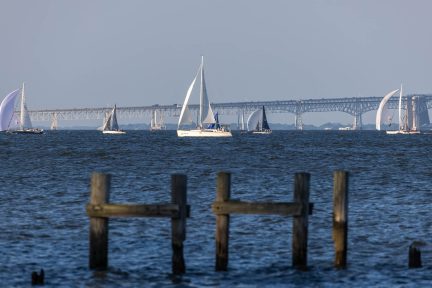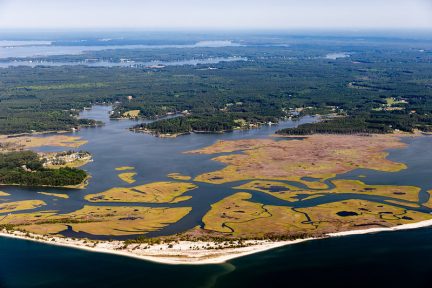2018 Blue Crab Advisory Report Released
2018 Blue Crab Advisory Report Released
The annual Blue Crab Advisory Report, released today by the Chesapeake Bay Program and developed by the Chesapeake Bay Stock Assessment Committee, finds that the overall Chesapeake Bay blue crab population decreased by almost 18 percent from 455 million in 2017 to 372 million in 2018.
The report provides scientific analysis of the Bay’s blue crab population to help Bay resource managers as they set blue crab fishing regulations. The Chesapeake Bay Program’s Sustainable Fisheries Goal Implementation Team recently approved the 2018 edition of the report.
According to the report and the scientific reference points that resource managers follow for “target” (healthy) and “threshold” (border between safe and unsafe) levels, the Chesapeake Bay blue crab population is currently not depleted, and it is not being overfished.
Notably, the estimated 2018 population of 147 million adult females was lower than the target of 215 million. Scientists place a special focus on females as they develop the analysis because they are key to future success of the species. In the 2017 blue crab fishing season, 21 percent of all female blue crabs were harvested—safely below the target (25.5 percent) and threshold (34 percent) levels.
The blue crab fishery in the Chesapeake Bay is managed by the Maryland Department of Natural Resources, Virginia Marine Resources Commission and Potomac River Fisheries Commission. The Blue Crab Advisory Report includes expert analysis of data from the annual Bay-wide Winter Dredge Survey (released earlier this year by the Maryland Department of Natural Resources) and harvest estimates from recent years.
The number of juvenile crabs—which will grow to be harvestable size this fall—increased by 34 percent from 2017 to 2018, while adult males decreased 23 percent from 76 to 58 million. Overwintering mortality—the measure of crabs that die between fall and spring, due to factors including water temperature—was 6.37 percent, slightly higher than the average of 4.6 percent.
The Advisory Report recommends:
- Jurisdictions should maintain a cautious, risk-averse approach in 2018; no adjustments to management are suggested.
- Jurisdictions should implement procedures that provide accurate accountability of all commercial and recreational harvest to enable more accurate future assessments of the Bay’s blue crab population.
This multiagency report supports the blue crab abundance outcome outlined in the Chesapeake Bay Watershed Agreement, which seeks to maintain a sustainable blue crab population, supporting healthy commercial and recreational harvest. The Blue Crab Advisory Report is developed by the Chesapeake Bay Stock Assessment Committee, a group of experts from state and federal agencies and academic institutions.
Facts
The Blue Crab Abundance outcome in the Chesapeake Bay Watershed Agreement is designed to maintain a sustainable blue crab population based on the current target of 215 million adult females. The Blue Crab Management outcome sets strategies for how the Chesapeake Bay Program works with stakeholders toward a stable and productive blue crab fishery.
Issues
Blue crab populations naturally can vary widely from year to year, based on weather, water temperature and other conditions, as well as on how much people work on catching them. Commercial fishermen rely on having a steady supply of crabs in the Bay, and recreational crabbers enjoy being able to catch crabs. Using science such as that included in the Blue Crab Advisory Report enables resource managers to set regulations that help support a sustainable blue crab population and promote coordination across the jurisdictions.
Importance
Blue crabs are an important part of the Chesapeake Bay’s ecology and economy. During the 2017 crabbing season, approximately 54 million pounds of blue crabs were harvested from the Bay and its tributaries by commercial fishermen—roughly 9.5% less than in 2016. Recreational crabbers harvested roughly 3.6 million pounds in 2017, a decrease from 4.2 million pounds the previous year.
Quotes
“Through the science in the Blue Crab Advisory Report, resource managers around the Bay have information and analysis they need to make informed decisions about blue crab fishing regulations. This year’s Report indicates we’re on a solid path and, thanks to the science involved, can enjoy eating crabs with friends and family this summer.”
—Sean Corson, Acting Director, NOAA Chesapeake Bay Office and Chair, Sustainable Fisheries Goal Implementation Team
“Although the number of spawning-age females is down from last year, we are pleased to see that their abundance is well above the minimum safe number even with the winter weather and lackluster reproduction last year. Last year we had very few young crabs entering the bay. Those juveniles grew through 2017 and endured this year’s cold winter to become the 2018 class of spawning adults.”
—Glenn Davis, Maryland Department of Natural Resources and Chair, Chesapeake Bay Stock Assessment Committee
“Having three jurisdictions and two academic agencies work in such a cooperative manner for the benefit of a shared natural resource as important as blue crab is noteworthy. Chesapeake Bay Stock Assessment Committee members all contribute to discussions on potential management actions, helping to ensure a sustainable crab population in the Chesapeake Bay.”
—Patrick Geer, Deputy Chief, Fisheries Management Division, Virginia Marine Resources Commission



